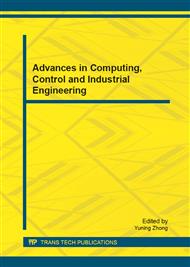[1]
M.A. Dornheim, Report pinpoints factors leading to YF–22 crash,Aviation Week Space Tech, 137(1992) 53-54.
Google Scholar
[2]
G. Stein, Respect the unstable, IEEE Contr. Syst. Mag., 23(2000), 12-25.
Google Scholar
[3]
S. Tarbouriech, M. Turner, Anti-windup design, an overview of some recent advances and open problems, IET Control Theory Appl., 3(2009), 1-19.
DOI: 10.1049/iet-cta:20070435
Google Scholar
[4]
A.H. Glatterfelder, W. Schaufelberger, Stability analysis of single loop control systems with saturation and antireset-windup circuits, IEEE T. Automat. Contr., 28(1983), 1074-1080.
DOI: 10.1109/tac.1983.1103180
Google Scholar
[5]
K. Yakoubi, Y. Chitour, Linear systems subject to input saturation and time delay, Global asymptotic stabilization, IEEE T. Automat. Contr., 52(2007), 874-879.
DOI: 10.1109/tac.2007.895916
Google Scholar
[6]
H. Xin, D. Gan, J. Qiu. Stability analysis of linear dynamical systems with saturation nonlinearities and a short time delay. Phys. Lett. A, 372(2008), 3999-4009.
DOI: 10.1016/j.physleta.2008.03.015
Google Scholar
[7]
L. Zhang, E. Boukas, A. Haidar. Delay-range-dependent control synthesis for time-delay systems with actuator saturation, Automatica, 44(2008), 2691-2695.
DOI: 10.1016/j.automatica.2008.03.009
Google Scholar
[8]
H.K. Khalil, J.W. Grizzle. Nonlinear systems. third ed, Upper Saddle River, Prentice Hall, (2002).
Google Scholar
[9]
H. Fang, Z. Lin, Y. Shamash, Disturbance tolerance and rejection of linear systems with imprecise knowledge of actuator input output characteristics, Automatica, 42(2006) , 1523-1530.
DOI: 10.1016/j.automatica.2006.04.008
Google Scholar
[10]
T.S. Hu, Z.L. Lin, Control systems with Actuator Saturation, Analysis and Design, Boston, (2001).
Google Scholar
[11]
T.S. Hu, Z.L. Lin, B.M. Chen, An analysis and design method for linear systems subject to actuator saturation and disturbance, Automatica, 38(2002), 351-359.
DOI: 10.1016/s0005-1098(01)00209-6
Google Scholar
[12]
T.S. Hu, Z.L. Lin, B.M. Chen, Analysis and design for discrete-time systems subject to actuator saturation, Control Lett., 45(2002), 87-112.
DOI: 10.1016/s0167-6911(01)00168-2
Google Scholar
[13]
J. Tu, H. He, Guaranteed cost synchronization of chaotic cellular neural networks with time-varying delay, Neural Comput., 24(2012), 217-233.
DOI: 10.1162/neco_a_00191
Google Scholar
[14]
J. Tu, H. He, P. Xiong, Guaranteed cost synchronous control of time-varying delay cellular neural networks. Neural Comput. & Applic., 2011, DOI, 10. 1007/s00521-011-0667-6.
DOI: 10.1007/s00521-011-0667-6
Google Scholar
[15]
H. He, L. Yan, J. Tu, Guaranteed cost stabilization of time–varying delay cellular neural networks via Riccati inequality approach, Neural Processing Letters, 35(2012), 151-158.
DOI: 10.1007/s11063-011-9208-7
Google Scholar
[16]
J.M. Gomes, S. Tarbouriech, Anti-windup design with guaranteed region of stability, an LMI-based approach. IEEE T. Automat. Contr., 50(2005), 106-111.
DOI: 10.1109/tac.2004.841128
Google Scholar
[17]
Y.Y. Cao,Z. Lin, D.G. Ward, An anti-windup approach to enlarging domain of attraction for linear systems subject to actuator saturation, IEEE T. Automat. Contr., 47(1), 140-145.
DOI: 10.1109/9.981734
Google Scholar
[18]
B. Lu, F. Wu, S. Kim, Linear parameter varying anti-windup compensation for enhanced flight control performance, AIAA J. Guid. Control Dyn, 28(2005), 494-504.
Google Scholar
[19]
M. Saeki, N. Wada , Synthesis of a static anti-windup compensator via linear matrix inequalities. Int. J. Robust Nonlin., 12(2002), 927-953.
DOI: 10.1002/rnc.673
Google Scholar
[20]
F. Wu , M. Soto, Extended anti-windup control schemes for LTI and LFT systems with actuator saturations, Int. J. Robust Nonlin., 14(2004), 1255-1281.
DOI: 10.1002/rnc.943
Google Scholar


